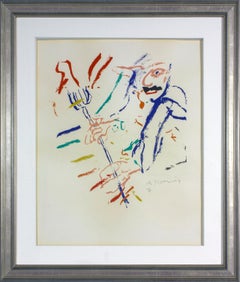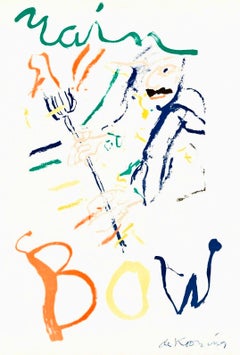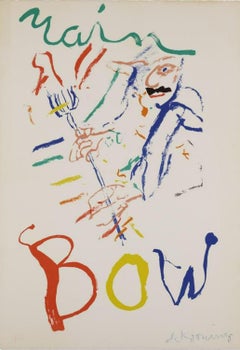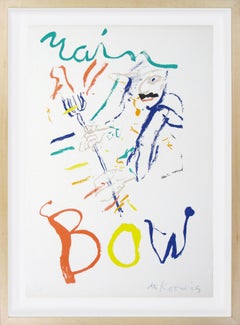Devil At The Keyboard
1970s Abstract Expressionist Figurative Prints
Lithograph
1970s Abstract Portrait Prints
Lithograph
1970s Abstract Expressionist Abstract Prints
Lithograph
Recent Sales
20th Century Contemporary Prints and Multiples
Lithograph
1970s Abstract Expressionist Prints and Multiples
Lithograph
1970s Abstract Expressionist Figurative Prints
Lithograph
1970s Abstract Expressionist Figurative Prints
Lithograph
1970s Abstract Expressionist Figurative Prints
Lithograph
1970s Abstract Expressionist Abstract Prints
Lithograph
1970s Abstract Expressionist Figurative Prints
Lithograph
1970s Abstract Expressionist Figurative Prints
Lithograph
1970s Abstract Expressionist Figurative Prints
Lithograph
1970s Abstract Expressionist Abstract Prints
Color, Lithograph
1970s Abstract Expressionist Figurative Prints
Lithograph
1970s Abstract Expressionist Figurative Prints
Lithograph
People Also Browsed
1980s Abstract Expressionist More Prints
Lithograph, Offset
1980s Abstract Expressionist Abstract Prints
Lithograph, Offset
21st Century and Contemporary Pop Art Portrait Prints
Giclée
Mid-20th Century Sculptures
Bronze
1970s Abstract Expressionist Abstract Prints
Lithograph, Offset
1980s Pop Art Figurative Prints
Offset
17th Century Old Masters Portrait Prints
Etching
1980s Pop Art More Art
Ink, Lithograph, Offset, Mixed Media
1970s Surrealist Abstract Prints
Paper, Lithograph
1980s Abstract Expressionist Abstract Prints
Lithograph
1970s Modern Figurative Prints
Lithograph
Antique 1880s American Prints
Gold Leaf
Mid-20th Century Post-War Abstract Paintings
Ink, Gouache
20th Century Cubist Figurative Prints
Linocut
1980s Pop Art More Art
Offset
Late 20th Century Abstract Expressionist Abstract Prints
Monotype
Willem de Kooning for sale on 1stDibs
As the de facto leader of the New York avant-garde art movement of the 1950s known as Abstract Expressionism, Dutch-American painter Willem de Kooning blended figuration and abstraction in a revolutionary manner that has resonated for decades. His best-known paintings, which were most often of women but gesturally abstract, were unique and incredibly influential at the time. Today, de Kooning is widely considered one of the most important artists of the 20th century.
De Kooning trained in fine and commercial arts at the Rotterdam Academy in his hometown of Rotterdam, the Netherlands, before immigrating to the United States in 1926. His first job in America was as a house painter in New Jersey, and the period left an indelible impression on him as he brought large brushes, loose strokes and fluid paints into his work as an artist. He also worked on public murals under President Franklin D. Roosevelt’s Works Progress Administration (WPA) program in the 1930s. De Kooning’s studies weren’t executed but they included some of his first abstractions, which showed the influence of like-minded artists as well as the music of the Jazz Age. His broad foundation in classical drawing and physical labor are evident even in the most abstract of his works, which amounted to a fusion of Cubism, Expressionism and Surrealism.
It was in New York that de Kooning found the space and an abundance of inspiration to pursue art full time. Surrounded by prominent artists like Jackson Pollock, Arshile Gorky, Lee Krasner and Fernand Léger, de Kooning drew from the freedom and boldness with which they all approached their work. In 1943, he married Elaine de Kooning, a versatile and immensely talented New York painter with a significant role in the Abstract Expressionist movement.
A major motif in de Kooning’s work is the deconstructed female form. A collection of paintings demonstrative of this is now known as his “Woman” series of the early 1950s, which remains controversial more than half a century later. Drawing inspiration from photography in magazines and using vivid colors and expressive brushstrokes to unforgettable effect, de Kooning depicted his subjects as grotesque, sexualized and loosely abstracted forms, which many critics deemed angry and misogynistic. But it is this very fearlessness in visual and conceptual experimentation that made de Kooning a crucial figure of Abstract Expressionism.
Today, de Kooning’s work is among the most coveted art in the world. His Interchange (1955), with its bold lines and shapes executed in primary colors, is one of the most expensive paintings ever sold.
Find a collection of Willem de Kooning art on 1stDibs.
A Close Look at Abstract Art
Beginning in the early 20th century, abstract art became a leading style of modernism. Rather than portray the world in a way that represented reality, as had been the dominating style of Western art in the previous centuries, abstract paintings, prints and sculptures are marked by a shift to geometric forms, gestural shapes and experimentation with color to express ideas, subject matter and scenes.
Although abstract art flourished in the early 1900s, propelled by movements like Fauvism and Cubism, it was rooted in the 19th century. In the 1840s, J.M.W. Turner emphasized light and motion for atmospheric paintings in which concrete details were blurred, and Paul Cézanne challenged traditional expectations of perspective in the 1890s.
Some of the earliest abstract artists — Wassily Kandinsky and Hilma af Klint — expanded on these breakthroughs while using vivid colors and forms to channel spiritual concepts. Painter Piet Mondrian, a Dutch pioneer of the art movement, explored geometric abstraction partly owing to his belief in Theosophy, which is grounded in a search for higher spiritual truths and embraces philosophers of the Renaissance period and medieval mystics. Black Square, a daringly simple 1913 work by Russian artist Kazimir Malevich, was a watershed statement on creating art that was free “from the dead weight of the real world,” as he later wrote.
Surrealism in the 1920s, led by artists such as Salvador Dalí, Meret Oppenheim and others, saw painters creating abstract pieces in order to connect to the subconscious. When Abstract Expressionism emerged in New York during the mid-20th century, it similarly centered on the process of creation, in which Helen Frankenthaler’s expressive “soak-stain” technique, Jackson Pollock’s drips of paint, and Mark Rothko’s planes of color were a radical new type of abstraction.
Conceptual art, Pop art, Hard-Edge painting and many other movements offered fresh approaches to abstraction that continued into the 21st century, with major contemporary artists now exploring it, including Anish Kapoor, Mark Bradford, El Anatsui and Julie Mehretu.
Find original abstract paintings, sculptures, prints and other art on 1stDibs.
Finding the Right Prints-works-on-paper for You
Decorating with fine art prints — whether they’re figurative prints, abstract prints or another variety — has always been a practical way of bringing a space to life as well as bringing works by an artist you love into your home.
Pursued in the 1960s and ’70s, largely by Pop artists drawn to its associations with mass production, advertising, packaging and seriality, as well as those challenging the primacy of the Abstract Expressionist brushstroke, printmaking was embraced in the 1980s by painters and conceptual artists ranging from David Salle and Elizabeth Murray to Adrian Piper and Sherrie Levine.
Printmaking is the transfer of an image from one surface to another. An artist takes a material like stone, metal, wood or wax, carves, incises, draws or otherwise marks it with an image, inks or paints it and then transfers the image to a piece of paper or other material.
Fine art prints are frequently confused with their more commercial counterparts. After all, our closest connection to the printed image is through mass-produced newspapers, magazines and books, and many people don’t realize that even though prints are editions, they start with an original image created by an artist with the intent of reproducing it in a small batch. Fine art prints are created in strictly limited editions — 20 or 30 or maybe 50 — and are always based on an image created specifically to be made into an edition.
Many people think of revered Dutch artist Rembrandt as a painter but may not know that he was a printmaker as well. His prints have been preserved in time along with the work of other celebrated printmakers such as Pablo Picasso, Salvador Dalí and Andy Warhol. These fine art prints are still highly sought after by collectors.
“It’s another tool in the artist’s toolbox, just like painting or sculpture or anything else that an artist uses in the service of mark making or expressing him- or herself,” says International Fine Print Dealers Association (IFPDA) vice president Betsy Senior, of New York’s Betsy Senior Fine Art, Inc.
Because artist’s editions tend to be more affordable and available than his or her unique works, they’re more accessible and can be a great opportunity to bring a variety of colors, textures and shapes into a space.
For tight corners, select small fine art prints as opposed to the oversized bold piece you’ll hang as a focal point in the dining area. But be careful not to choose something that is too big for your space. And feel free to lean into it if need be — not every work needs picture-hanging hooks. Leaning a larger fine art print against the wall behind a bookcase can add a stylish installation-type dynamic to your living room. (Read more about how to arrange wall art here.)
Find fine art prints for sale on 1stDibs today.



